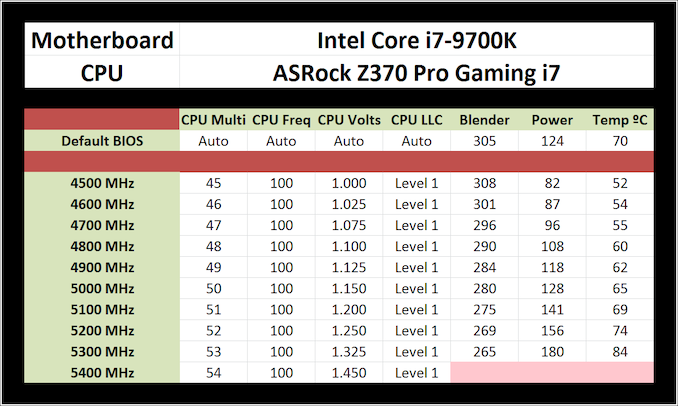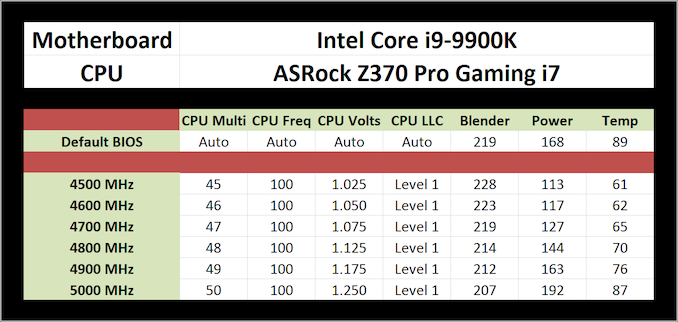The Intel 9th Gen Review: Core i9-9900K, Core i7-9700K and Core i5-9600K Tested
by Ian Cutress on October 19, 2018 9:00 AM EST- Posted in
- CPUs
- Intel
- Coffee Lake
- 14++
- Core 9th Gen
- Core-S
- i9-9900K
- i7-9700K
- i5-9600K
Overclocking
With the upgraded thermal interface between the processor and the heatspreader, from paste to solder, Intel is leaning on the fact that these overclockable processors should be more overclockable than previous generations. We’ve only had time to test the Core i9-9900K and i7-9700K on this, so we took them for a spin.
Our overclocking methodology is simple. We set the Load Line Calibration to static (or level 1 for this ASRock Z370 motherboard), set the frequency to 4.5 GHz, the voltage to 1.000 volts, and run our tests. If successfully stable, we record the power and performance, and then increase the CPU multiplier. If the system fails, we increase the voltage by +0.025 volts. The overclocking ends when the temperatures get too high (85C+).
For our new test suite comes new overclocking features. As mentioned in the previous page, our software loading for power measurement is POV-Ray, which can thrash a processor quite harshly. POV-Ray also does a good job on stability, but is not a substantial enough test – for that we use our Blender workload, which pushes the cores and the memory, and lasts about 5 minutes on an 8 core processor.
Results as follows:
For the Core i7-9700K, we hit 5.3 GHz very easily, for a small bump in power and temperature. For 5.4 GHz, we could boot into the operating system but it was in no way stable – we were ultimately voltage/temperature limited at this case. But an eight core, eight thread 5.3 GHz CPU at 180W for $374? Almost unimaginable a year ago.
Overclocking the Core i9-9900K was not as fruitful. The best bit about this overclock is the 4.7 GHz value: by using our own voltage settings, we reduced power consumption by 41W, almost 25% of the total power, and also reduced temperatures by 24ºC. That's a safe idea. Even 4.8 GHz and 4.9 GHz was reasonable, but the temperatures at 5.0 GHz might not be for everyone. When all cores and threads are loaded, this is one warm chip.












274 Comments
View All Comments
0ldman79 - Friday, October 19, 2018 - link
There are certainly occasions where more cores are better than clock speed.Just look at certain mining apps. You can drop the power usage by half and only lose a little processing speed, but drop them to 2 cores at full power instead of 4 and it is a *huge* drop. Been playing with the CPU max speed in Windows power management on my various laptops. The Skylake i5 6300HQ can go down to some seriously low power levels if you play with it a bit. The recent Windows updates have lost a lot of the Intel Dynamic Thermal control though. That's a shame.
Makaveli - Friday, October 19, 2018 - link
Power consumption rules on mobiles parts why would they release an 8 core model?notashill - Friday, October 19, 2018 - link
Because you get more performance at the same power level using more cores at lower clocks. The additional cores are power gated when not in use.evernessince - Saturday, October 20, 2018 - link
Not judging by the power consumption and heat output displayed here.mkaibear - Friday, October 19, 2018 - link
9700K is definitely the way to go on the non-HEDT. 9900K is technically impressive but the heat? Gosh.It's definitely made me consider waiting for the 9800X though - if the 7820X full load power is 145W ("TDP" 140W) at 3.6/4.3, then the 9800X isn't likely to be too much higher than that at 3.8/4.5.
Hrm.
Cooe - Friday, October 19, 2018 - link
"9700K is definitely the way to go on the non-HEDT."I think you meant to say "Ryzen 5 2600 unless your GPU's so fast, it'll HEAVILY CPU-bind you in gaming" but spelt it wrong ;). The 9700K is a vey good CPU, no doubt, but to claim it the undisputed mainstream champ at it's currently mediocre bang/$ value (so important for the mainstream market) doesn't make any sense, or accurately represent what people in the mainstream are ACTUALLY buying (lots of Ryzen 5 2600's & i5-8400's; both with a MUCH saner claim to the "best overall mainstream CPU" title).
mkaibear - Saturday, October 20, 2018 - link
No, I meant to say "9700K is definitely the way to go on the non-HEDT".Don't put words in people's mouth. I don't just game. The video encoding tests in particular are telling - I can get almost a third better performance with the 9700K than I can the r5 2600x.
>"best overall mainstream CPU" title
Please don't straw man either. Nowhere did I say that it was the best overall mainstream CPU (that's the R7 2700X in my opinion), but for my particular use case the 9700K or the 9800X are better suited at present.
koaschten - Friday, October 19, 2018 - link
Uhm yeah... so where are the 9900k overclocking results the article claims are currently being uploaded? :)watzupken - Friday, October 19, 2018 - link
The i9 processor is expected to be quite impressive in performance. However this review also reveals that Intel is struggling to pull more tricks out of their current 14nm and Skylake architect. The lack of IPC improvement over the last few generations is just forcing them to up the clockspeed to continue to cling on to their edge. Considering that they are launching the new series this late in the year, they are at risk of AMD springing a surprise with their 7nm Zen 2 slated to launch next year.SquarePeg - Friday, October 19, 2018 - link
If the rumored 13% IPC and minimum 500mhz uplift are for real with Zen 2 then AMD would take the performance crown. I'm not expecting very high clocks from Intel's relaxed 10nm process so it remains to be seen what kind of IPC gain they can pull with Ice Lake. It wouldn't surprise me if they had a mild performance regression because of how long they had to optimize 14nm for clock speed. Either way I'm all in on a new Ryzen 3 build next year.